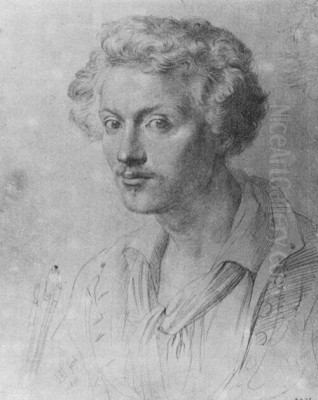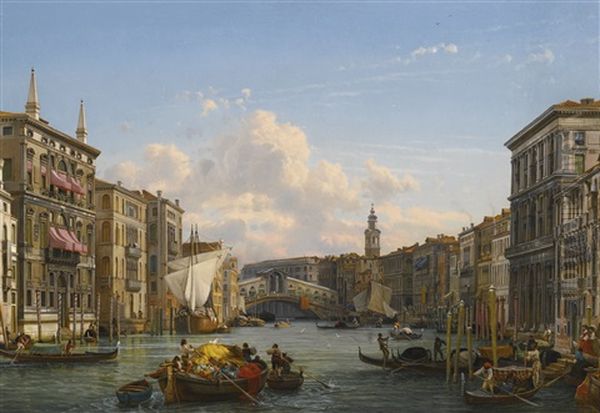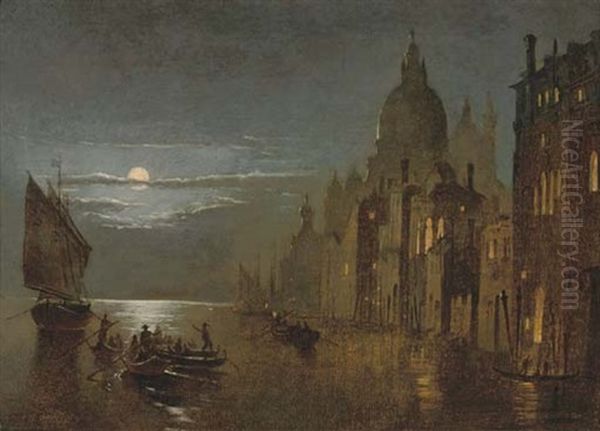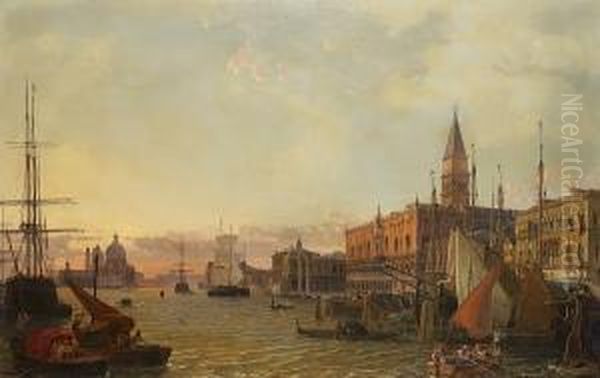
Friedrich Nerly stands as a significant figure in 19th-century German Romantic painting, celebrated primarily for his evocative landscapes, particularly his atmospheric depictions of Venice. Born Christian Friedrich Wilhelm Nehrlich in Erfurt, Thuringia, in 1807, he later adopted the Italianized surname "Nerly" upon settling in Venice, the city that would become his lifelong muse and the subject of his most iconic works. His paintings, especially those capturing the ethereal beauty of Venice by moonlight or during sunset, masterfully blend topographical accuracy with profound Romantic sensibility, securing his place as a key interpreter of the Venetian scene for a European audience captivated by Italy's allure.
Early Life and Artistic Awakening in Germany
Nerly's journey into the world of art began under challenging circumstances. Born into a family with modest means – his father was a post office official in Erfurt – young Friedrich faced early hardship with the premature death of his father. Responsibility for his upbringing fell to relatives, specifically an uncle, Heinrich Joachim Dewitz, who was a musician in Hamburg. This move to the bustling port city proved pivotal. In Hamburg, Nerly's nascent artistic talent was recognized, leading to formal training.
His most crucial early influence was the Baron Carl Friedrich von Rumohr, a multifaceted figure known not only as a landowner and gastronome but also as a significant art historian, writer, and patron. Around 1823, Nerly became a protégé, essentially an apprentice, in Rumohr's circle. Rumohr was not a conventional painting instructor but rather a mentor who guided Nerly's intellectual and artistic development. He encouraged rigorous observation of nature, a cornerstone of landscape painting, while also instilling an appreciation for the classical ideals and the history of art. Rumohr's connections and guidance opened doors for the young artist, shaping his path towards Italy.

During these formative years in Hamburg and under Rumohr's tutelage, Nerly honed his skills in drawing and painting. He absorbed the prevailing artistic currents of North German art, likely engaging with the works of local artists, though his primary development was steered by Rumohr's specific interests, which leaned towards a blend of naturalism and idealized form, influenced by his own studies of Italian art history. This period laid the technical and intellectual groundwork for his future specialization in landscape.
The Call of Italy: Rome and Early Influences
The dream of Italy, a near-obligatory pilgrimage for Northern European artists since the Renaissance, became a reality for Nerly in 1827-1828. He embarked on the journey south in the company of his mentor, Baron von Rumohr. This Italienreise (Italian Journey) was a transformative experience, exposing Nerly to the landscapes, light, and artistic heritage that had inspired generations before him. Their travels took them through various parts of Germany, including Weimar, where they likely encountered circles associated with Goethe, before crossing the Alps.
Their primary destination was Rome. Arriving in the Eternal City, Nerly was immersed in a vibrant international artistic community, particularly the significant contingent of German-speaking artists known as the Deutschrömer. Rome at this time was a crucible of artistic ideas. Nerly interacted with established figures of German Neoclassicism and Romanticism who resided there, such as the landscape painters Joseph Anton Koch and Johann Christian Reinhart, known for their heroic depictions of the Roman Campagna. He also likely encountered artists associated with the Nazarene movement, like Friedrich Overbeck, though Nerly's own path diverged from their religious and historical focus.
In Rome, Nerly dedicated himself to studying the city's ancient ruins and the surrounding countryside, the Campagna. He sketched prolifically, capturing the unique light and atmosphere of central Italy. His works from this period, such as The Villa of Tivoli and the Temple of Vesta and Ceres, demonstrate his growing mastery of landscape composition and his absorption of the Italianate style. He learned from the established traditions of depicting these famous sites, yet began to infuse them with a more personal, Romantic sensibility, focusing on mood and the play of light. The influence of French artists active in Rome, like Camille Corot, who was also exploring plein-air sketching and atmospheric effects, might also be considered part of the milieu.
Venice: A Lifelong Muse

While Rome provided crucial training and exposure, it was Venice that truly captured Nerly's artistic soul. After several years based primarily in Rome and traveling through southern Italy, Nerly made a decisive move in 1835: he settled permanently in Venice. Marking this new chapter, he Italianized his surname from Nehrlich to Nerly, a name under which he would achieve widespread recognition. He would remain in Venice for the rest of his life, over four decades, becoming one of the city's most prominent resident foreign artists.
The reasons for choosing Venice were likely manifold. The city offered a unique visual spectacle unlike any other – a cityscape built on water, characterized by shimmering reflections, dramatic architecture, and a constantly changing interplay of light and atmosphere. For a landscape painter increasingly interested in atmospheric effects, Venice was an inexhaustible source of inspiration. Furthermore, Venice was a major hub on the Grand Tour circuit, attracting wealthy travelers from across Europe and America, creating a ready market for high-quality views (vedute) of the city's famous landmarks.
Nerly quickly established himself within the Venetian art scene. He opened a studio and began producing the views that would become his trademark. His decision to stay, rather than return to Germany or continue traveling, suggests a deep personal and artistic connection to the city. He integrated into Venetian life, eventually marrying Agathe Alginovich, the daughter of a local noble family, and raising a family there. His son, Friedrich Paul Nerly (often called Nerly the Younger), also became a painter, following in his father's footsteps.
Capturing the Soul of Venice: Style and Technique
Friedrich Nerly's art is firmly rooted in German Romanticism, but his long residency in Venice gave his work a unique character. Romanticism, as a broad movement, emphasized emotion, individualism, the power of nature, and often a fascination with the past and the exotic. Nerly channeled these sensibilities into his depictions of Venice. While he painted topographical views, his approach differed significantly from the earlier, more objective vedute tradition exemplified by artists like Canaletto and Francesco Guardi in the 18th century.
Nerly's primary interest lay in capturing the mood and atmosphere of Venice, particularly during transitional times of day or under specific weather conditions. His most famous and sought-after works are his nocturnal scenes and sunsets. He excelled at rendering the effects of moonlight on the city's architecture and canals, using subtle gradations of tone and carefully placed highlights to create scenes of quiet mystery and romance. His depictions of the Piazzetta di San Marco by moonlight became particularly iconic, produced in numerous variations for eager clients.

His technique involved meticulous observation combined with a poetic interpretation. He paid close attention to the play of light on water, the reflections of buildings, and the soft diffusion of light in the humid Venetian air. His palette often employed warm tones, especially in sunset scenes, contrasting with the cool blues and silvers of his nocturnes. There's a palpable sense of atmosphere in his work, sometimes compared to the hazy, light-filled landscapes of the English painter John Constable, though Nerly's subject matter and specific handling remained distinct.
The influence of J.M.W. Turner, the great English Romantic painter who also visited Venice and was renowned for his revolutionary depictions of light and atmosphere, is often discussed in relation to Nerly. While direct influence is hard to pinpoint definitively, Nerly was certainly aware of Turner's work and shared a similar fascination with capturing transient light effects. Nerly, however, generally maintained a greater degree of topographical clarity than Turner's more abstract late works. He was also influenced by painters like Louis Léopold Robert, known for incorporating genre elements into Italian landscapes, which can sometimes be seen in the figures populating Nerly's Venetian scenes.
Masterpieces of the Lagoon
Throughout his long career in Venice, Nerly produced a substantial body of work, revisiting certain favoured locations multiple times. Among his most celebrated and representative paintings are:
Piazzetta in Venice by Moonlight: This subject, often featuring the two famous columns of St. Mark and St. Theodore against a moonlit sky, with the Doge's Palace and the Biblioteca Marciana flanking the space, was arguably Nerly's signature piece. He painted numerous versions, varying the viewpoint, the phase of the moon, and the arrangement of gondolas and figures. These works perfectly encapsulate the Romantic vision of Venice – historic, beautiful, and slightly melancholic under the nocturnal glow. St. Mark’s Column in Venice, by Moonlight is likely one specific title for a version of this popular theme.
View of the Bacino di San Marco in Venice: This panoramic view captures the bustling heart of maritime Venice, looking across the basin towards the island of San Giorgio Maggiore or along the Riva degli Schiavoni. These paintings often showcase Nerly's skill in rendering water, shipping (gondolas, sailing vessels), and the intricate details of Venetian architecture under daylight conditions, often the warm light of late afternoon or sunset. The interplay of light on the water and the distant silhouettes are key features.

A view of the Grand Canal looking towards the Rialto Bridge, Venice: Depictions of the Grand Canal, the city's main waterway, were another staple. Views looking towards the iconic Rialto Bridge, often painted from a slightly elevated viewpoint, allowed Nerly to explore the perspective of the canal lined with palazzi. He captured these scenes both by day and, notably, by night, again employing his mastery of light effects to convey the unique atmosphere of the canal after dark.
The Arts in Conflict: While primarily a landscape painter, Nerly occasionally explored other subjects. This watercolour depicts an artist's studio, possibly in Venice, showing artists at work. It offers a glimpse into the creative environment of the time and showcases his skill in a different medium and genre, focusing on figure composition and interior space.
These works, along with numerous other views of Venetian canals, churches, and squares, solidified Nerly's reputation. They were highly sought after by collectors and tourists participating in the Grand Tour, serving as sophisticated souvenirs and testaments to the allure of Venice.
Nerly and His Contemporaries
Nerly's artistic life was interwoven with the careers of many other artists, both through direct interaction and shared artistic currents. His relationship with Carl Friedrich von Rumohr was foundational, providing mentorship and entry into the Italo-German art world. In Rome, his encounters with figures like Koch and Reinhart placed him within the lineage of German landscape painting in Italy.
His time in Venice brought him into contact or parallel activity with other artists drawn to the city. The potential encounter or awareness of J.M.W. Turner's Venetian work represents a significant point of comparison in the exploration of light and atmosphere. While perhaps not direct collaborators, their shared interest in Venice as a subject for Romantic interpretation is notable.
He was also contemporary with other prominent German landscape painters who worked in Italy, such as the Achenbach brothers, Andreas Achenbach and Oswald Achenbach, leading figures of the Düsseldorf school known for their dramatic seascapes and Italian scenes. Carl Blechen, another important German Romantic landscape painter, also travelled to Italy and shared an interest in capturing atmospheric effects and architectural subjects, though with a distinct style.

Nerly's success in the Venetian art market inevitably placed him in a competitive landscape with other vedute painters, both Italian and foreign, who catered to the tourist trade. His ability to consistently produce high-quality, atmospheric works that appealed to Romantic tastes allowed him to thrive in this environment. His influence extended to younger artists as well; for instance, the Danish painter Peter Christian Petersen Funch is noted to have been inspired by Nerly's practice of using paper for oil studies during his time in Italy.
Later Life and Legacy
Friedrich Nerly remained a productive artist in Venice throughout his later years. He continued to paint his beloved Venetian scenes, adapting subtly to changing tastes while retaining his core Romantic style. His studio remained a point of interest for visiting art lovers. His son, Friedrich Paul Nerly, carried on the family's artistic tradition in Venice.
Nerly died in Venice on October 21, 1878, having spent the majority of his life in his adopted city. His death marked the end of a significant era for German Romantic painting in Italy. His legacy, however, was carefully preserved. A substantial part of his artistic estate, including numerous oil paintings, sketches, and drawings, was bequeathed to his native city of Erfurt.
This generous donation formed the core of the painting gallery at the Angermuseum in Erfurt. Today, the Angermuseum holds the most important collection of Nerly's work worldwide, providing invaluable insight into his artistic development, from his early studies to his mature Venetian masterpieces. This collection ensures his enduring recognition in Germany and serves as a vital resource for scholars studying 19th-century landscape painting.
Nerly's enduring appeal lies in his ability to capture not just the physical appearance of Venice, but its intangible atmosphere – the romance, the history, the unique interplay of light, stone, and water. He translated the visual poetry of the city into paintings that resonated deeply with the sensibilities of his time and continue to captivate viewers today.
Conclusion

Friedrich Nerly occupies a distinct and important place in the history of 19th-century European art. As a German artist who made Venice his home and primary subject, he bridged the traditions of Northern European Romanticism with the specific visual allure of the Italian lagoon city. His mastery of light, particularly in his celebrated moonlight and sunset scenes, allowed him to move beyond mere topographical representation to evoke the powerful emotions and poetic atmosphere associated with Venice. Mentored by Rumohr, influenced by the Italian landscape tradition, and contemporary to giants like Turner, Nerly forged a unique style that found immense favour with the public and secured his lasting reputation. Through his prolific output and the significant collection preserved in Erfurt's Angermuseum, Friedrich Nerly remains celebrated as a quintessential painter of Romantic Venice, a master interpreter of its enduring magic.